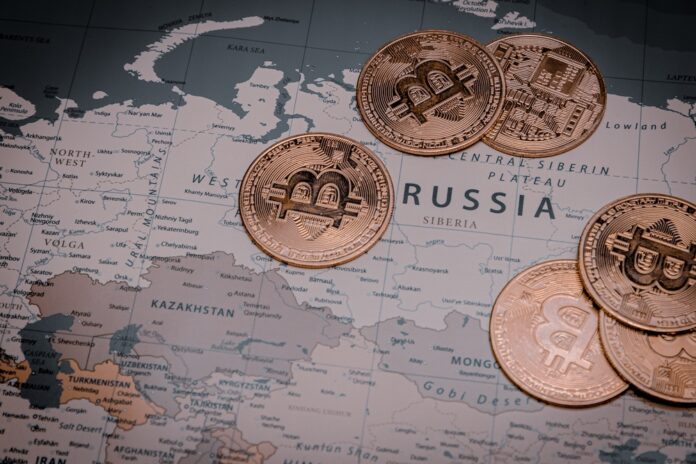BNB Chain
Russian Crypto Mining Expands as Others Capitulate – Blockchain News, Opinion, TV and Jobs
Published
1 year agoon
By
admin
By Marcus Sotiriou, Market Analyst at the publicly listed digital asset broker GlobalBlock (TSXV:BLOK)
Bitcoin’s comeback has stalled at the $24,000 level, as it retraced last night to $22,700. Bitcoin just broke down from an up-trending line of support on the lower time frame (LTF), so we could see further downside in the short term. The next key level of support is $21,500.
Russia’s capacity for crypto mining has increased significantly, according to a survey of leading operators. This survey claims that the total capacity of crypto farms in Russia has expanded to 500 MW, showing how Russian crypto miners are preparing for growth. Executives have cautioned that growth could be limited by the government’s decision on whether to impose electricity tariffs and taxes. In addition, Russian miners are under threat from US sanctions – particularly Bitriver, which was targeted by the US. Nonetheless, Bitriver, the largest Russian miner, has capitalised on depressed mining equipment prices as they doubled the amount of their data centres. They recognise the advantages that Russia has with its abundant energy resources and the long term opportunity if/when crypto prices recover.
Separately, a recent Messari report highlighted the opportunities of BNB Chain this year. The report mentioned a focus on growth strategies, scaling solutions and Ethereum Virtual Machine implementation. Messari said, “The team plans to expand the network with L2-like solutions, such as ZK-rollups and sidechains, and to increase decentralization by open-sourcing the validator set. Despite several challenges along the way, BNB Chain successfully executed its 2022 roadmap … After a dramatic year with many challenges, BNB Chain looks to remain competitive heading into 2023.” Indeed, daily active addresses on BNB chain grew last year as average daily transactions remained steady at approximately 3.4 million per day. During a persistently down trending market, these statistics are noteworthy and signal strength.
Source link
You may like


Insight Into The Timing And Factors


Bitcoin About To ‘Blow Higher’ Despite This Week’s Pullback, According to Glassnode Co-Founders – Here’s Why


Azuro and Chiliz Working Together to Boost Adoption of Onchain Sport Prediction Markets – Blockchain News, Opinion, TV and Jobs


Robinhood Bleeds 164 Million Dogecoin


AIGOLD Goes Live, Introducing the First Gold Backed Crypto Project – Blockchain News, Opinion, TV and Jobs


Analyst Benjamin Cowen Warns Ethereum ‘Still Facing Headwinds,’ Says ETH Will Only Go Up if Bitcoin Does This
BNB Chain
BNB hacker loses over $53M after getting liquidated in market crash
Published
9 months agoon
August 18, 2023By
admin
The sudden market crash in the crypto space liquidated many traders — and according to data shown on the blockchain, the attackers responsible for the infamous BNB Chain exploit which led to the theft of almost $600 million worth of BNB (BNB) tokens.
On Oct. 6, the cross-chain bridge by blockchain network BNB Chain was suspended because of an exploit that allowed the hackers to make off with 2 million BNB tokens, which were worth around $568 million at the time of the theft.
On Aug. 18, a crypto wallet linked to the exploit had its collateral, worth more than $53 million, liquidated on the crypto lending platform Venus Protocol, according to blockchain security firm PeckShield. The hacker apparently used the tokens as collateral for a $30 million Tether (USDT) loan on the protocol.

On Aug. 18, the entire crypto market suffered a 6% drop, sending the overall market capitalization to $1.1 trillion, according to coin information sites. The event wiped out over $1 billion in crypto positions in the last 24 hours according to market data tracker Coinglass.
The BNB chain hackers were also affected as the price of BNB dropped below $220. According to blockchain data, three positions linked to the wallet were automatically liquidated after the price fell. At the moment, BNB trades at $218 per token.
Related: Liquid staking claims top spot in DeFi: Binance report
While many suffered losses as a result of the massive drop in the market, some were able to minimize the damage. Days before the crash, a crypto whale sold 22,341 Ether (ETH), worth around $41 million, and avoided a potential loss of over $5 million in value. Despite this, the crypto trader still lost around $1.7 million in the trade.
Magazine: Should we ban ransomware payments? It’s an attractive but dangerous idea
Source link

Insight Into The Timing And Factors

Bitcoin About To ‘Blow Higher’ Despite This Week’s Pullback, According to Glassnode Co-Founders – Here’s Why

Azuro and Chiliz Working Together to Boost Adoption of Onchain Sport Prediction Markets – Blockchain News, Opinion, TV and Jobs

Robinhood Bleeds 164 Million Dogecoin

AIGOLD Goes Live, Introducing the First Gold Backed Crypto Project – Blockchain News, Opinion, TV and Jobs

Analyst Benjamin Cowen Warns Ethereum ‘Still Facing Headwinds,’ Says ETH Will Only Go Up if Bitcoin Does This

Tron Price Prediction: TRX Outperforms Bitcoin, Can It Hit $0.132?

Ethereum-Based Altcoin Leads Real-World Assets Sector in Development Activity, According to Santiment

Here’s Why This Analyst Is Predicting A Rise To $360

Hackers With $182,000,000 Stolen From Poloniex Starts Moving Funds to Tornado Cash

Cardano Faces Make-Or-Break Price Level For Bullish Revival

A Premier Crypto Exchange Tailored for Seasoned Traders – Blockchain News, Opinion, TV and Jobs

Crypto Whale Withdraws $75.8 Million in USDC From Coinbase To Invest In Ethereum’s Biggest Presale – Blockchain News, Opinion, TV and Jobs

CFTC Chair Says ‘Another Cycle of Enforcement Actions’ Coming As Crypto Enters New Phase of Asset Appreciation

Spectral Labs Joins Hugging Face’s ESP Program to advance the Onchain x Open-Source AI Community – Blockchain News, Opinion, TV and Jobs

Bitcoin Dropped Below 2017 All-Time-High but Could Sellers be Getting Exhausted? – Blockchain News, Opinion, TV and Jobs

What does the Coinbase Premium Gap Tell us about Investor Activity? – Blockchain News, Opinion, TV and Jobs
BNM DAO Token Airdrop

NFT Sector Keeps Developing – Number of Unique Ethereum NFT Traders Surged 276% in 2022 – Blockchain News, Opinion, TV and Jobs
New Minting Services

Block News Media Live Stream
A String of 200 ‘Sleeping Bitcoins’ From 2010 Worth $4.27 Million Moved on Friday

SEC’s Chairman Gensler Takes Aggressive Stance on Tokens – Blockchain News, Opinion, TV and Jobs

Friends or Enemies? – Blockchain News, Opinion, TV and Jobs

Enjoy frictionless crypto purchases with Apple Pay and Google Pay | by Jim | @blockchain | Jun, 2022

Block News Media Live Stream

How Web3 can prevent Hollywood strikes

Block News Media Live Stream

XRP Explodes With 1,300% Surge In Trading Volume As crypto Exchanges Jump On Board

Block News Media Live Stream
Trending

 Altcoins2 years ago
Altcoins2 years agoBitcoin Dropped Below 2017 All-Time-High but Could Sellers be Getting Exhausted? – Blockchain News, Opinion, TV and Jobs

 Binance2 years ago
Binance2 years agoWhat does the Coinbase Premium Gap Tell us about Investor Activity? – Blockchain News, Opinion, TV and Jobs
- Uncategorized2 years ago
BNM DAO Token Airdrop

 BTC1 year ago
BTC1 year agoNFT Sector Keeps Developing – Number of Unique Ethereum NFT Traders Surged 276% in 2022 – Blockchain News, Opinion, TV and Jobs
- Uncategorized3 years ago
New Minting Services

 Video2 years ago
Video2 years agoBlock News Media Live Stream

 Bitcoin miners2 years ago
Bitcoin miners2 years agoA String of 200 ‘Sleeping Bitcoins’ From 2010 Worth $4.27 Million Moved on Friday

 Bitcoin1 year ago
Bitcoin1 year agoSEC’s Chairman Gensler Takes Aggressive Stance on Tokens – Blockchain News, Opinion, TV and Jobs


